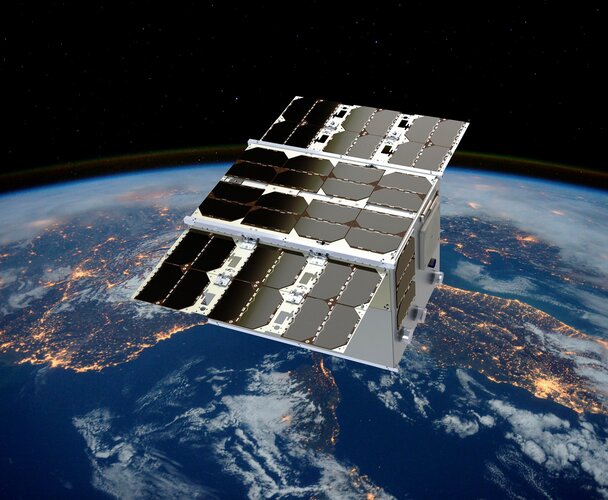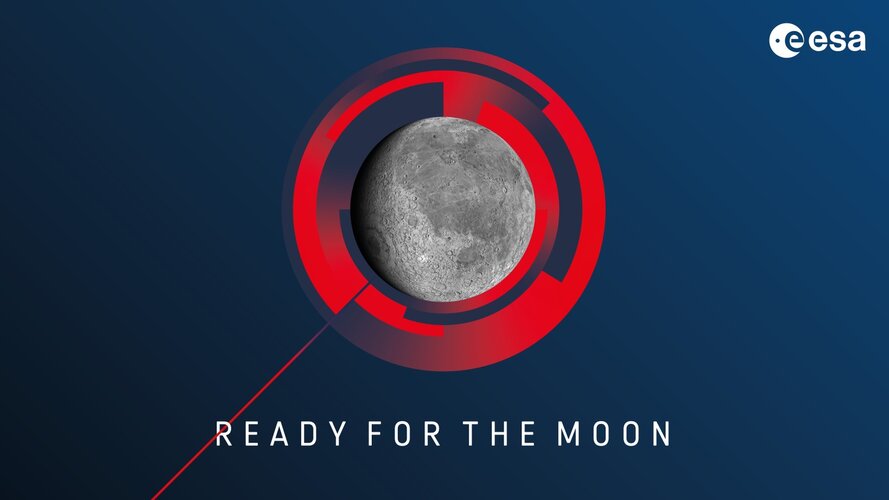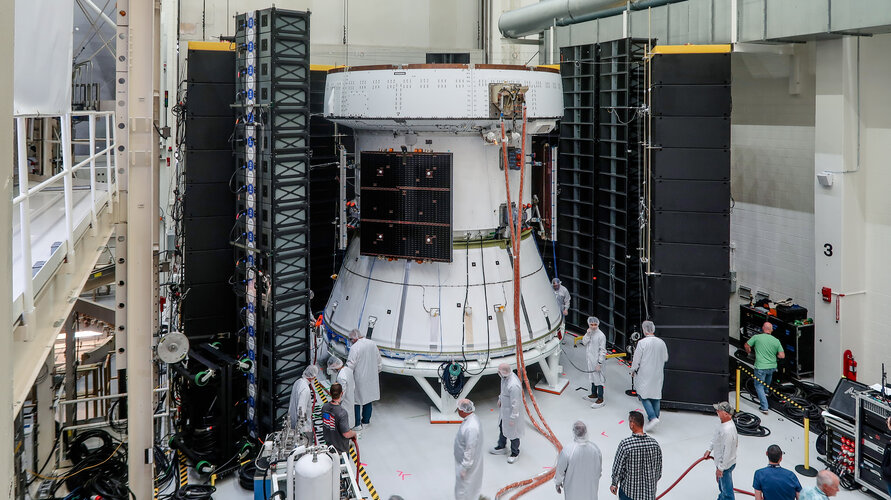CubeMAP mission development halted
Thursday, 01 June 2023 11:00
After very careful consideration, ESA’s Earth Observation Programme Board has taken the decision to terminate the development of CubeMAP as a Scout satellite mission. This decision is based on the development path exceeding the programmatic constraints related to the timeline and budgetary boundaries allocated for this category of New Space mission.
30 Kilometers and Counting: Sols 3845-3847
Thursday, 01 June 2023 10:38 Earth planning date: Tuesday, May 30, 2023. What do you do when you are driving through challenging terrain? Well, hit a new record! Tosol we have passed the 30 kilometer mark! That's a Mars rover milestone only the NASA Opportunity rover has reached so far. That was around June 2011 and just over 2610 sols into the mission with Opportunity on its way between Victoria and Endeavour Crater. At En
Earth planning date: Tuesday, May 30, 2023. What do you do when you are driving through challenging terrain? Well, hit a new record! Tosol we have passed the 30 kilometer mark! That's a Mars rover milestone only the NASA Opportunity rover has reached so far. That was around June 2011 and just over 2610 sols into the mission with Opportunity on its way between Victoria and Endeavour Crater. At En Canadian NIRISS instrument on Webb maps an ultra-hot Jupiter atmosphere
Thursday, 01 June 2023 10:38 There's an intriguing exoplanet out there - 400 light-years out there - that is so tantalising that astronomers have been studying it since its discovery in 2009. One orbit for WASP-18 b around its star that is slightly larger than our Sun takes just 23 hours. There is nothing like it in our Solar System.
A new study led by Universite de Montreal Ph.D. student Louis-Philippe Coulombe about
There's an intriguing exoplanet out there - 400 light-years out there - that is so tantalising that astronomers have been studying it since its discovery in 2009. One orbit for WASP-18 b around its star that is slightly larger than our Sun takes just 23 hours. There is nothing like it in our Solar System.
A new study led by Universite de Montreal Ph.D. student Louis-Philippe Coulombe about Orbit Fab selects Impulse Space to support GEO refueling mission
Thursday, 01 June 2023 10:38 Impulse Space has announced a hydrazine refueling demonstration mission in geostationary equatorial orbit (GEO), where its Mira orbital service vehicle will serve as a hosting platform for the Orbit Fab fuel depot set to replenish Space Force Satellites in 2025.
"We are eager to collaborate with Orbit Fab, a forerunner in commercial spacecraft refueling services," said Impulse Space Chief
Impulse Space has announced a hydrazine refueling demonstration mission in geostationary equatorial orbit (GEO), where its Mira orbital service vehicle will serve as a hosting platform for the Orbit Fab fuel depot set to replenish Space Force Satellites in 2025.
"We are eager to collaborate with Orbit Fab, a forerunner in commercial spacecraft refueling services," said Impulse Space Chief Novel docking system to be tested on the International Space Station
Thursday, 01 June 2023 10:38 Similar to the droids we see in movies, astronauts on the International Space Station (ISS) use their own free-flying robotic helpers called Astrobees. Queen, Honey, and Bumble are a trio of cube-shaped robots buzzing around station. They assist crew members with a multitude of tasks, including helping to perform ISS National Laboratory-sponsored investigations to test new technology that could
Similar to the droids we see in movies, astronauts on the International Space Station (ISS) use their own free-flying robotic helpers called Astrobees. Queen, Honey, and Bumble are a trio of cube-shaped robots buzzing around station. They assist crew members with a multitude of tasks, including helping to perform ISS National Laboratory-sponsored investigations to test new technology that could A telescope's last view
Thursday, 01 June 2023 10:38 More than 5,000 planets are confirmed to exist beyond our solar system. Over half were discovered by NASA's Kepler Space Telescope, a resilient observatory that far outlasted its original planned mission. Over nine and a half years, the spacecraft trailed the Earth, scanning the skies for periodic dips in starlight that could signal the presence of a planet crossing in front of its star.
I
More than 5,000 planets are confirmed to exist beyond our solar system. Over half were discovered by NASA's Kepler Space Telescope, a resilient observatory that far outlasted its original planned mission. Over nine and a half years, the spacecraft trailed the Earth, scanning the skies for periodic dips in starlight that could signal the presence of a planet crossing in front of its star.
I Viasat completes acquisition of Inmarsat
Thursday, 01 June 2023 10:38 Viasat Inc., (NASDAQ: VSAT), a global communications company, has announced the completion of its acquisition of Inmarsat. The combined company enhances our scale and scope to continue to drive growth in the increasingly dynamic and competitive satellite communications industry. The company's assets, once fully integrated, are expected to increase the pace and scope of innovation in the global s
Viasat Inc., (NASDAQ: VSAT), a global communications company, has announced the completion of its acquisition of Inmarsat. The combined company enhances our scale and scope to continue to drive growth in the increasingly dynamic and competitive satellite communications industry. The company's assets, once fully integrated, are expected to increase the pace and scope of innovation in the global s Momentus to deliver Lunasonde technology demonstration payload to orbit
Thursday, 01 June 2023 10:38 Momentus Inc. (NASDAQ: MNTS) has signed a contract with Lunasonde to deliver the Picacho CubeSat to orbit.Lunasonde is a sub-surface imaging company with the goal of making underground resources - like water and minerals - easier to find.
The Picacho CubeSat is a technology demonstration of Lunasonde's sensors. It will measure the power spectral density of low-frequency radio signals in th
Momentus Inc. (NASDAQ: MNTS) has signed a contract with Lunasonde to deliver the Picacho CubeSat to orbit.Lunasonde is a sub-surface imaging company with the goal of making underground resources - like water and minerals - easier to find.
The Picacho CubeSat is a technology demonstration of Lunasonde's sensors. It will measure the power spectral density of low-frequency radio signals in th Lockheed Martin working with US Army to improve space-enabled defense systems
Thursday, 01 June 2023 10:38 Lockheed Martin signed a Cooperative Research and Development Agreement (CRADA) with the U.S. Army Combat Capabilities Development Command's Aviation and Missile Center (AvMC) to advance Beyond Line of Sight (BLOS) connectivity. Under this CRADA, Lockheed Martin and AvMC will jointly develop and demonstrate space-enabled defense systems.
What It Means: Through this CRADA, Lockheed Martin a
Lockheed Martin signed a Cooperative Research and Development Agreement (CRADA) with the U.S. Army Combat Capabilities Development Command's Aviation and Missile Center (AvMC) to advance Beyond Line of Sight (BLOS) connectivity. Under this CRADA, Lockheed Martin and AvMC will jointly develop and demonstrate space-enabled defense systems.
What It Means: Through this CRADA, Lockheed Martin a Northrop Grumman advances sensing technology for space domain awareness
Thursday, 01 June 2023 10:38 In a significant leap for space domain awareness, Northrop Grumman Corporation (NYSE: NOC) has announced the successful completion of the Critical Design Review (CDR) and a software demonstration for the U.S. Space Force's Deep-Space Advanced Radar Capability Program (DARC). This announcement comes just one year after the contract award, demonstrating Northrop Grumman's ability to swiftly meet k
In a significant leap for space domain awareness, Northrop Grumman Corporation (NYSE: NOC) has announced the successful completion of the Critical Design Review (CDR) and a software demonstration for the U.S. Space Force's Deep-Space Advanced Radar Capability Program (DARC). This announcement comes just one year after the contract award, demonstrating Northrop Grumman's ability to swiftly meet k BlackSky and SynMax partner to monitor US Coal Powerplant Inventory
Thursday, 01 June 2023 10:38 BlackSky Technology Inc. (NYSE: BKSY) was competitively selected by energy intelligence company SynMax to monitor more than 100 United States coal powerplants. The partnership will create the world's most timely and accurate energy intelligence assessment and support national energy transition initiatives away from fossil fuels toward alternate, more sustainable energy resources.
"BlackSky
BlackSky Technology Inc. (NYSE: BKSY) was competitively selected by energy intelligence company SynMax to monitor more than 100 United States coal powerplants. The partnership will create the world's most timely and accurate energy intelligence assessment and support national energy transition initiatives away from fossil fuels toward alternate, more sustainable energy resources.
"BlackSky Register for ESA's first Earth observation commercialisation event
Thursday, 01 June 2023 10:38 Registration is now open for ESA's first-ever Earth Observation Commercialisation Forum. Taking place at ESA Headquarters in Paris from 30 to 31 October 2023, investors, institutions, entrepreneurs and companies of any size from the Earth observation sector will now be able to come together and discuss the commercial potential and challenges of Earth observation, together with the technical, ind
Registration is now open for ESA's first-ever Earth Observation Commercialisation Forum. Taking place at ESA Headquarters in Paris from 30 to 31 October 2023, investors, institutions, entrepreneurs and companies of any size from the Earth observation sector will now be able to come together and discuss the commercial potential and challenges of Earth observation, together with the technical, ind Dream Chaser moves a step closer to first launch
Thursday, 01 June 2023 10:02
Sierra Space’s Dream Chaser took a step closer to its long-awaited first flight by powering up its systems in a key test.
Watch live: ‘Ready for the Moon’ conference
Thursday, 01 June 2023 09:11
Join us live to follow the ‘Ready for the Moon’ event, a high-level political conference on the challenges and ambitions for Europe's space sector. ESA Web TV will broadcast on its Channel Two the conference, including the media briefing on 2 June starting at 14:00 CEST (13:00 BST).


 Image:
Trial by sound
Image:
Trial by sound